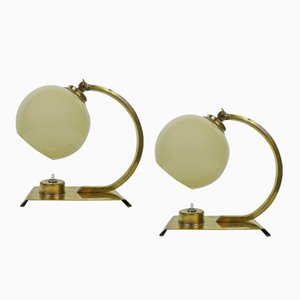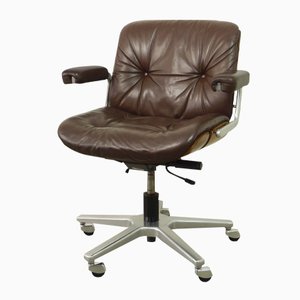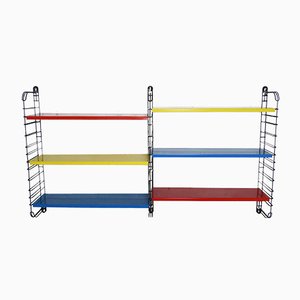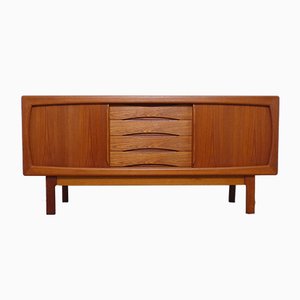Getting to Know Berlin-Based Stilspiel
Kreuzberg Style
Just a stone’s throw from Kreuzberg’s vibrant and frenzied Oranienstraße, Malte Henkel and Evelyn Lang’s vintage haven, Stilspiel, sits tucked into a laid-back side street with a vibe that’s decidedly local. There’s not a tourist in sight, despite the neighborhood’s current status as the hippest in Berlin. Still, the streetscape is 100% Kreuzberg, reflecting its long history of welcoming workers, immigrants, anarchists, and artists. The 19th-century building that houses the shop—as well as the couple’s home—drips with ivy and welcoming charm, a spirited companion to the hard-nosed, graffiti-tagged, 1960s apartment block directly opposite.
Inside Stilspiel, the layers of history continue. Since 2007, Henkel and Lang have filled the bi-level space with an eclectic mix of 20th-century design classics and curiosities, ranging from the subdued silhouettes of Bauhaus and Scandinavian modernism to the exuberant, Space Age forms of the ’60s and ’70s. They’re self-taught experts, eager to elaborate on the stories behind each piece in their collection. Even more than that, their expertise extends into the details of materials and processes, so they’re able to restore their vintage finds to original condition. It’s a labor of love that we can relate to. So we recently spent an afternoon with the Stilspiel owners to talk craftsmanship, Ikea, and Kreuzberg life.
Matilda Lucy: Take us back to the beginnings of Stilspiel. How did it all begin?
Malte Henkel: After finishing university, we knew one thing for sure: we wanted to be in Berlin. I studied communications, and Evelyn studied art history; we were looking to start a joint venture that combined both of our skills and passions. For me, the most important thing was to have a job that allowed me to use my hands as well as my head. Throughout university I worked as a craftsman for extra cash and after graduating I worked as an assistant for an antiques specialist for almost a year.
We fell in love with the abandoned space on the ground floor of this building and eventually persuaded the landlord to let us take it over. During the first few months, we were actually building our own furniture to sell, but we soon realized there was not enough time to do everything. We decided to concentrate on collecting, restoring, and selling vintage pieces.
ML: You have your shop, flat, and workshop in the same building. Does that get a bit intense?
MH: We really love having everything in the same space. During the shop’s opening hours, we can be working downstairs in the workshop and run back up the stairs when we hear the front door. In our flat, upstairs, we experiment and get to know the furniture. We try new materials and techniques on our own furniture, mixing up styles and seeing what will work well together.
ML: Your collection mixes designs from famous, 20th-century designers with unknown pieces. How do you choose the objects you bring into the shop?
MH: For us, the most important thing is the quality of the piece. We’re not searching for famous names; we search piece by piece for designs that work well and are made to the highest standard. Years of restoring pieces in our workshop have trained us to be able to quickly recognize how well a piece has been designed and produced. Of course, often when you’re looking for the best quality designs, you do tend to stumble across the big names.
ML: As vintage specialists, how do you feel about the less expensive, mass-produced furniture that has prevailed in our “buy-use-throw-away” culture?
MH: Everyone starts with a Billy Bookshelf from Ikea. That’s normal; that’s ok! In recent years, though, we feel there has been a change in the “second-wave” of furniture buyers—people who are in their thirties, who have a bit more money for the first time and are beginning to value their time spent at home more. They don’t want to be contributing to the landfills already overflowing with discarded furniture; they’re more interested in buying quality pieces that will last. People are starting to realize that by building up your interior slowly, you can create a unique and durable living space with character.
ML: Slow and mindful living—with a renewed focus on traditional crafts like carpentry—has had a millennial resurgence. But I understand these traits have run in your family for a few generations. Is that right?
MH: My grandfather was an upholsterer, my father worked as a chief engineer and my mother took me to auctions from a very early age in search of Biedermeier furniture. She loved the style so much that she would pick up pieces in any state and restore them to their original grandeur as a hobby. So I learned a lot just watching my mother and father work at home.
ML: Your restoration techniques focus heavily on returning pieces to their original condition. How do you feel about the current trend of upcycling, or restoring vintage pieces in a way that’s not original to the design?
MH: I think that anything that involves reusing materials that would otherwise be thrown away can only a positive thing. In this sense, it is similar to our own process of preserving furniture but it is not exactly the same. Our work concentrates on retaining the originality of the design and respects the designers construct of ideas.
ML: You are currently exhibiting the works of several artists alongside your furniture. How fluid is the relationship between art and design for you?
MH: Although we concentrate on vintage design ourselves, we think that this is the perfect space to showcase contemporary art; the line between the two is so blurred. Most of the artists are local and have completely varied styles. If we like the work of an artist and think it will fit our collection, we just invite them to exhibit.
Evelyn Lang: Generally nowadays, more artists are designing limited-edition furniture. Certain designs are now as collectible as works of art and are sold for higher and higher prices at auction each year. For example Eileen Gray's Drachensessel was sold for over 20 million euros in Paris in 2009, the highest price ever paid for a piece of 20th century furniture. Design and art are linked more closely than ever before.
ML: How long has Kreuzberg been your home?
MH: Almost 25 years. I came to Berlin at the beginning of the 1990s, when it was still very ’80s. I did what every young person new to Berlin does: I moved from neighborhood to neighborhood until I found one that fit. And for us, that was Kreuzberg.
ML: You are located in the heart of Kreuzberg, arguably Berlin’s most creative neighborhood. How have you seen this area change over the years?
MH: It’s not so ’80s anymore, and the streets are a lot cleaner. Since I arrived, Kreuzberg has always been home to a wide array of people. And today there are more people from more places than ever before, which I think is great. We have countless different cuisines at our doorstep, because people from so many backgrounds now call Kreuzberg home.
Of course, with the positive changes come the negative side effects of rising rent prices, but overall I think that Kreuzbergers are still as politically engaged as they have ever been. We will still unite quickly against any looming political change that we feel is wrong, and I really like that.
ML: Where are your favorite spots in the neighborhood?
MH: As a former part of West Berlin, Kreuzberg is still home to old artisanal specialists, who sell tools and parts for woodworking, upholstery, electrical components, etc. The former Eastern districts, such as Friedrichshain, don’t have so many of these ateliers. This means we can walk to pick up any parts we need for our restoration processes really easily.
After working in the workshop all day, we love to get outside in the evenings and enjoy the nature in the area. We can walk a 10km circuit through only parks and green spaces. That’s really unique to Berlin. There are also a lot of great restaurants and street food in our area!
ML: Do you feel you have a collection that will appeal particularly to Berliners?
MH: Berlin is home to open-minded, international people. So, in this sense, yes. It’s home to so many more vintage furniture boutiques than most other cities in Europe—partly because the demand for vintage designs here is so high. Saying this, we have an eclectic mix of styles in our collection and customers as far flung as New York and Tokyo. So although it’s based in Berlin, it attracts a wide audience.
-
Text von
-
Matilda Lucy
A sun-seeking Mancunian with a passion for all things French, Matilda taught English to sommeliers in the south of France and lobbied for international publishing rights in Brussels before moving to Berlin. Though she’s yet to win the Tour de France, Matilda can often be found cycling round Berlin, discovering the city’s endless hidden treasures.
-
-
Fotos von
-
Ramtin Zanjani
Beyond his role as Pamono’s Head of Photography, Ramtin has honed his keen eye through years of product shoots, art direction, advertising, and documentary work. He doesn’t like to talk about it, but he has some searing photographs available at SaatchiArt.com.
-
More to Love
Automatic 2 Speed Table Fan from Philips, 1960s

Swedish Teak Wall Unit by Nisse Strinning for String, 1950s

Swedish Wall Unit with Four Teak Shelves by Nisse Strinning for String, 1950s

Art Deco Table Lamps, 1930s, Set of 2

French Lamella Lamp by Henri Mathieu for Mathieu Lighting, 1970s

Adjustable Yellow Table Light by Hustadt-leuchten, 1960s

Vintage German Tulip Base Floor Lamp from Staff, 1960s

Teak Wall Shelf with Drawers by Nisse Strinning for String Design AB, 1950s

Wind Light from Kristallglaswerk Hirschberg, 1960s

Rosewood Sideboard by Gunni Omann for Omann Jun. Mobelfabrik, 1960s

Danish Model 71 Teak Dining Chairs by Niels Otto Moller for J.L. Møllers, 1960s, Set of 6

Mid-Century Danish Folding Safari-Style Chair, 1960s

Eva Dining Chairs by Niels Koefoed for Koefoeds Hornslet, 1960s, Set of 4

Contract Table by Charles & Ray Eames for Herman Miller, 1970s

Swiss Fun 0 DM Chandelier by Verner Panton for J. Luber AG, 1964

Swiss Office Swivel Chair from Stoll Giroflex, 1970s

German White Cascade Lamp from Kaiser Leuchten, 1960s

Flexible German Z-Lite Desk Lamp from Brilliant Leuchten, 1970s

Long Teak Shelf by Walter Wirtz for Wilhelm Renz, 1960s

Vintage Plant-Shaped Floor Lamp

Vintage Gold-Leaf Flower Wall Lamp

Danish Fruitbowl Table by Kistian Solmer Vedel for Soren Willadsen

Dutch Multicolored Metal Rack by Adrian Dekker for Tomado, 1950s

Danish Teak Sideboard with Sliding Doors and Drawers from Dyrlund, 1960s



